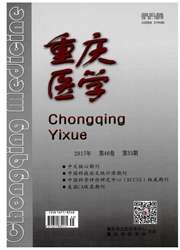

 中文摘要:
中文摘要:
目的探讨不同探针浓度对蛋白质-DNA相互作用新型压电生物传感器结合效应的影响。方法将6种不同浓度NF—κB顺式作用元件(DNA)探针通过巯基化法固定在传感器的金膜表面,并与特异性蛋白NF—κB的p65亚基进行结合反应,通过计算机采集分析传感器频率数据,观察不同浓度探针与p65亚基结合反应所引起的频率变化及反应所需的时间。结果在DNA顺式作用元件探针浓度为0.25~3.0μmol/L的范围内,随着探针浓度的增加,p65蛋白与DNA探针结合反应所引起的传感器频率变化逐渐增加,当探针浓度为2.0μmol/L时所引起的频率变化与探针浓度为3.0μmol/L所引起的频率变化差异无统计学意义(P〉0.05);同时p65蛋白与DNA的结合反应平衡时间随着探针浓度的增加有缩短趋势,当探针浓度为2.0μmol/L时,结合反应平衡时间最短为15min。结论随着DNA探针浓度的增加,蛋白质-DNA结合反应引起的频率下降呈典型的饱和曲线趋势,探针浓度为2.0μmol/L、反应时间为15min,是蛋白质-DNA相互作用压电生物传感器的最适结合反应条件。
 英文摘要:
英文摘要:
Objective To investigate the Effects of the probe concentration on the detection time of a novel biosensor based on protein-DNA reaction. Methods Cis-acting element probes of NF-κB were immobilized on the gold membrane surface of the sensor by thiol-self-assembly technique at six different DNA probe concentrations and the binding reaction of p65 subunit of NF-κB with DNA probe was made. Then the data such as sensor frequency changes and reaction time were collected and analyzed by computer. Results The values of frequency changes caused by probes binding with p65 protein increased with increasing of the probes concentrations from 0.25μmol/L to 3.0μmol/L, But which was not significant different between the 2.0μmol/L and 3.0μmol/L(P)0. 05). In addition, the reaction time of p65 protein and DNA showed deeurtation tendency with increasing of DNA probe concentration and the shortest reaction time was 15 min at 2. 0μmol/L probe concentration. Conclusion The frequency change caused by protein-DNA reaction is a typical saturation curve in accordance with increasing of DNA probe concentration. Therefore, 2.0μmol/L DNA probe concentration and 15 min reaction time are optimized work conditions of the novel piezoelectric biosensor based on protein-DNA reaction.
 同期刊论文项目
同期刊论文项目
 同项目期刊论文
同项目期刊论文
 期刊信息
期刊信息
